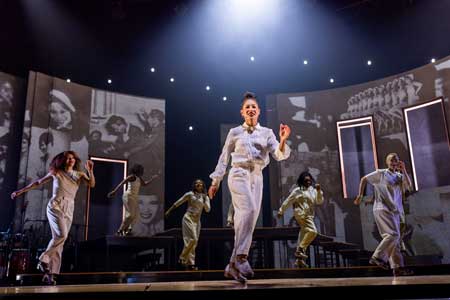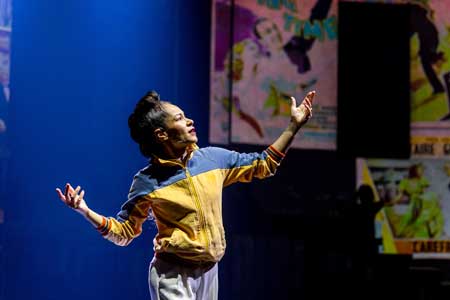Play, Performance, Dance
Written and Choreographed by Ayodele Casel
Directed by Torya Beard
American Repertory Theater
Loeb Drama Center, Harvard University
Harvard Square, Cambridge, MA
December 12, 2024 – January 4, 2025
Music Director: Nick Wilders; Scenic Design: Tatiana Kahvegian; Costume Design: Camilla Dely; Lighting Design: Brandon Stirling Baker; Sound Design: Sharath Patel; Projection Design: Katherine Freer; Compositions, Orchestrations, and Arrangements: Carlos Cippelletti, Ethan D. Pakchar
Musicians: Keisel Jiménez Leyva (drums), Carlos Cippelletti (Piano), Raul Reyes Bueno (Bass)
With Ayodele Casel, Naomi Funaki, Afra Hines, Quynn L. Johnson, Funmi Sofola, Liberty Styles, Annaliese Wilbur, Ki’Leigh Williams

in “Diary of a Tap Dancer”
Photo: Nile Scott Studios and Maggie Hall
Courtesy of American Repertory Theater
Ayodele Casel is the subject and the sole narrator of this captivating, moving and thoroughly entertaining treatment of her life, her career and the challenges faced by women tap-dancers over the past century. There is a good deal of talk, mostly by Casel, and much of it about herself, which might seem off-putting, but it’s not. She couches her own passions and struggles in the context of the world that women tap dancers, and in particular those of color, have faced, and the show is clearly a paean to her antecedents as well as an opportunity to show her own stuff.
And boy does she show her own stuff. Casel is an unbelievable tap dancer and takes many opportunities throughout the show to riff and dazzle and it is thrilling. She clearly loves to dance, and avows that love has carried her through all kinds of challenges over the years. But, along with the many opportunities to show her own talents, Casel includes those of a backup troupe of seven other women, all incredibly accomplished. The sense of camaraderie and the interest in working together comes through clearly. There are times when each member takes a solo, but there are also times when all eight of them are dancing in unison with unbelievable accuracy. The steps they do together are over-the-top complex and that they can maintain such uniformity and precision is truly a miracle.
Part of the narrative that Casel tells is that of the female, and mainly black, lines of dancing girls who populated such places as the Apollo Theater in Harlem and who worked incredible hours to hone their performances. At one point Casel tells of how the women at the Apollo had fifteen hour rehearsal days for a show which changed every week. And she added – with the applause of the audience – that those women went on strike, albeit briefly, and managed to cut down their rehearsal time considerably. Honoring those lines of dancing women who, largely unknown or under-celebrated through the years, is a large part of the narrative context for Casel’s autobiographical foray.
The choreography is incredibly varied and interesting. Of course, there is mostly tap and it is thrilling. But there is also a section in which one of the dancers in the troupe dances more in an African style to a background beat of bongos and congas. Gradually, that dance morphs into a dominantly tap number with the large group of women in such a way that one understands how the music and the moves that supported tap evolved from African beginnings. It’s a clever, artful and quite brilliant interlude that helps one to get in a visceral and direct way an organic sense of the roots of this art form.

in “Diary of a Tap Dancer”
Photo: Nile Scott Studios and Maggie Hall
Courtesy of American Repertory Theater
Casel tells the story of growing up with a mother from Puerto Rico and a father who was black but largely absent until she sought him out. The poignancy of that story rides along with Casel’s tale of her going to live in Puerto Rico for a number of years, then coming back to New York, and wanting to find a sense of connection with her black as well as Hispanic roots.
While developing this narrative about her personal history, Casel uncovers the way in which she came to tap dancing. As a student at NYU in the 1990s, she came upon tap as one of the options for an alternative class to the T’ai Chi she had been taking, and it really clicked (so to speak). She was bitten by the bug and tried to find her way into classes and improv spaces but for a woman it was particularly difficult. As Casel shows in a brief filmed quote from the legendary tap dancer Gregory Hines, tap was a man’s world. But Casel was persistent and hung around studios until she was admitted, and she gradually prevailed. At one point, she became successful and was even featured on the cover of The Village Voice.
But that success also had some liabilities in terms of Casel’s relations with other women tap dancers, who seemed to feel it was a little too self-involved and perhaps indulgent. So, the current show, though as autobiogarphy quite self-involved, it is also a tribute to women in general, and to the collective struggle of women to find their ways in such art-realms together.
This show is indeed full of verbal narrative as well as dance, but it is, in addition to a personal history, a real history lesson about women in the tap-dancing world and the challenges they faced, and as well about the challenges faced by women of color. Additionally, Casel notes that she has a wife, and, as a gay married person, also has come to represent a minority that has been severely challenged over the years and which now has achieved some degree of freedom of expression and equal rights.
The choreography in this show is truly exquisite, and the show is beautifully written. As well, the production values are tastefully done – with adept and artful lighting and music, and with a constant array of informative and interesting projections and videos. Sometimes shows at the ART get a little tech-heavy, but this one is just perfect – utilizing the skills of the ART tech mavens without going overboard.
The show is indeed entertaining and highly informative, but also very moving. Clearly, when Casel speaks of the challenges that particular women of talent have faced in past decades, she chokes up, and the palpability of the feelings behind this performance are evident.
Apart from everything else, one marvels at Casel who, close to fifty, bangs out number after number and comes away only with a slight hint of being short of breath. She is a true force of nature, clearly evident in so many ways from this production, and the women who support her in dance and drama, and the several men who provide the music, have contributed forcefully to this excellent production.
Overall: Exquisitely done – moving, entertaining, artful, informative – don’t miss it.
– BADMan (aka Charles Munitz)
Leave a Reply